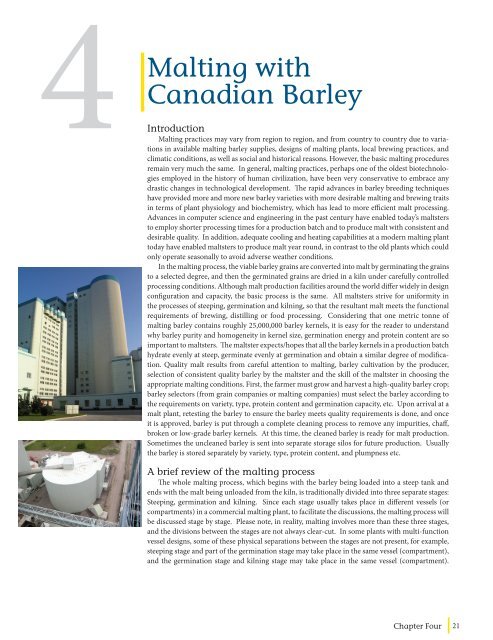MALTING QUALITY TRAITS - Canadian Malting Barley Technical ...
MALTING QUALITY TRAITS - Canadian Malting Barley Technical ...
MALTING QUALITY TRAITS - Canadian Malting Barley Technical ...
Create successful ePaper yourself
Turn your PDF publications into a flip-book with our unique Google optimized e-Paper software.
4 Introduction<br />
<strong>Malting</strong> practices may vary from region to region, and from country to country due to varia-<br />
<strong>Malting</strong> with<br />
<strong>Canadian</strong> <strong>Barley</strong><br />
tions in available malting barley supplies, designs of malting plants, local brewing practices, and<br />
climatic conditions, as well as social and historical reasons. However, the basic malting procedures<br />
remain very much the same. In general, malting practices, perhaps one of the oldest biotechnologies<br />
employed in the history of human civilization, have been very conservative to embrace any<br />
drastic changes in technological development. The rapid advances in barley breeding techniques<br />
have provided more and more new barley varieties with more desirable malting and brewing traits<br />
in terms of plant physiology and biochemistry, which has lead to more efficient malt processing.<br />
Advances in computer science and engineering in the past century have enabled today’s maltsters<br />
to employ shorter processing times for a production batch and to produce malt with consistent and<br />
desirable quality. In addition, adequate cooling and heating capabilities at a modern malting plant<br />
today have enabled maltsters to produce malt year round, in contrast to the old plants which could<br />
only operate seasonally to avoid adverse weather conditions.<br />
In the malting process, the viable barley grains are converted into malt by germinating the grains<br />
to a selected degree, and then the germinated grains are dried in a kiln under carefully controlled<br />
processing conditions. Although malt production facilities around the world differ widely in design<br />
configuration and capacity, the basic process is the same. All maltsters strive for uniformity in<br />
the processes of steeping, germination and kilning, so that the resultant malt meets the functional<br />
requirements of brewing, distilling or food processing. Considering that one metric tonne of<br />
malting barley contains roughly 25,000,000 barley kernels, it is easy for the reader to understand<br />
why barley purity and homogeneity in kernel size, germination energy and protein content are so<br />
important to maltsters. The maltster expects/hopes that all the barley kernels in a production batch<br />
hydrate evenly at steep, germinate evenly at germination and obtain a similar degree of modification.<br />
Quality malt results from careful attention to malting, barley cultivation by the producer,<br />
selection of consistent quality barley by the maltster and the skill of the maltster in choosing the<br />
appropriate malting conditions. First, the farmer must grow and harvest a high-quality barley crop;<br />
barley selectors (from grain companies or malting companies) must select the barley according to<br />
the requirements on variety, type, protein content and germination capacity, etc. Upon arrival at a<br />
malt plant, retesting the barley to ensure the barley meets quality requirements is done, and once<br />
it is approved, barley is put through a complete cleaning process to remove any impurities, chaff,<br />
broken or low-grade barley kernels. At this time, the cleaned barley is ready for malt production.<br />
Sometimes the uncleaned barley is sent into separate storage silos for future production. Usually<br />
the barley is stored separately by variety, type, protein content, and plumpness etc.<br />
A brief review of the malting process<br />
The whole malting process, which begins with the barley being loaded into a steep tank and<br />
ends with the malt being unloaded from the kiln, is traditionally divided into three separate stages:<br />
Steeping, germination and kilning. Since each stage usually takes place in different vessels (or<br />
compartments) in a commercial malting plant, to facilitate the discussions, the malting process will<br />
be discussed stage by stage. Please note, in reality, malting involves more than these three stages,<br />
and the divisions between the stages are not always clear-cut. In some plants with multi-function<br />
vessel designs, some of these physical separations between the stages are not present, for example,<br />
steeping stage and part of the germination stage may take place in the same vessel (compartment),<br />
and the germination stage and kilning stage may take place in the same vessel (compartment).<br />
Chapter Four<br />
21


